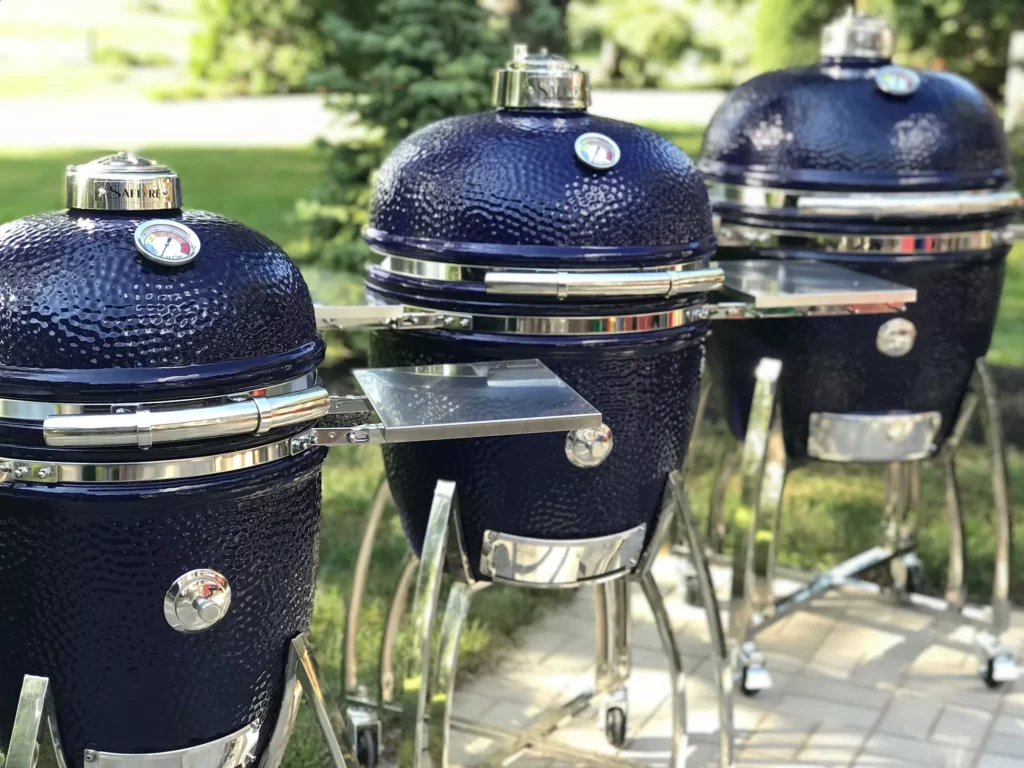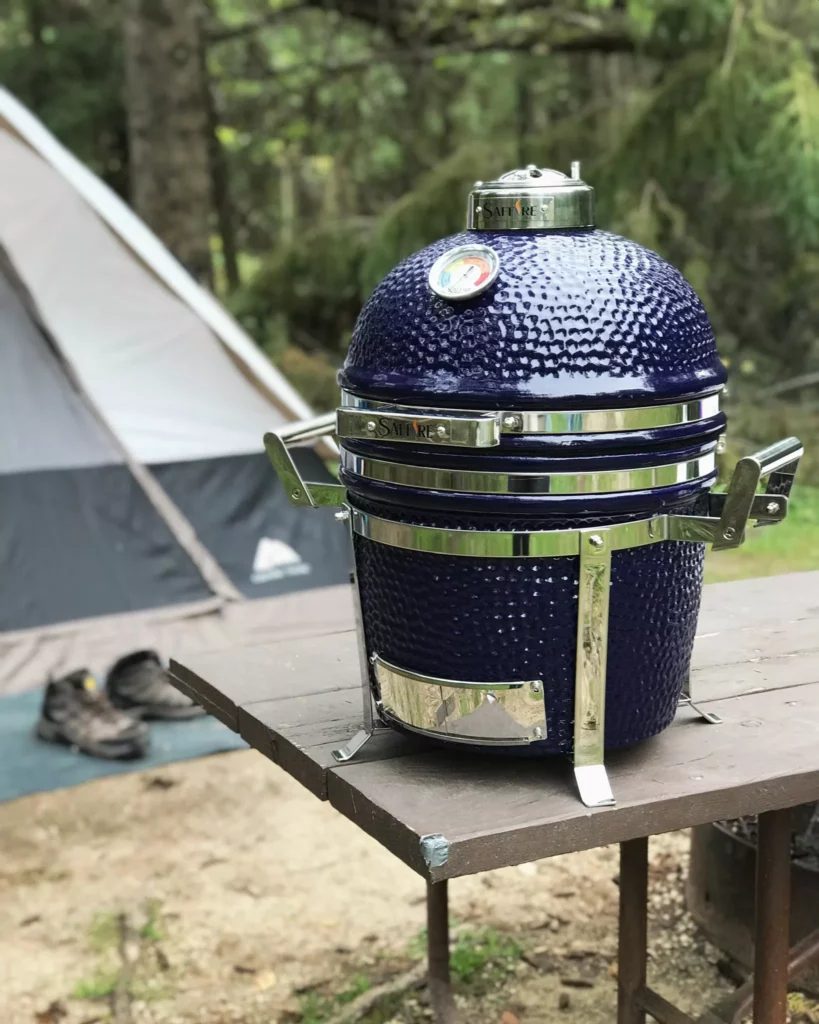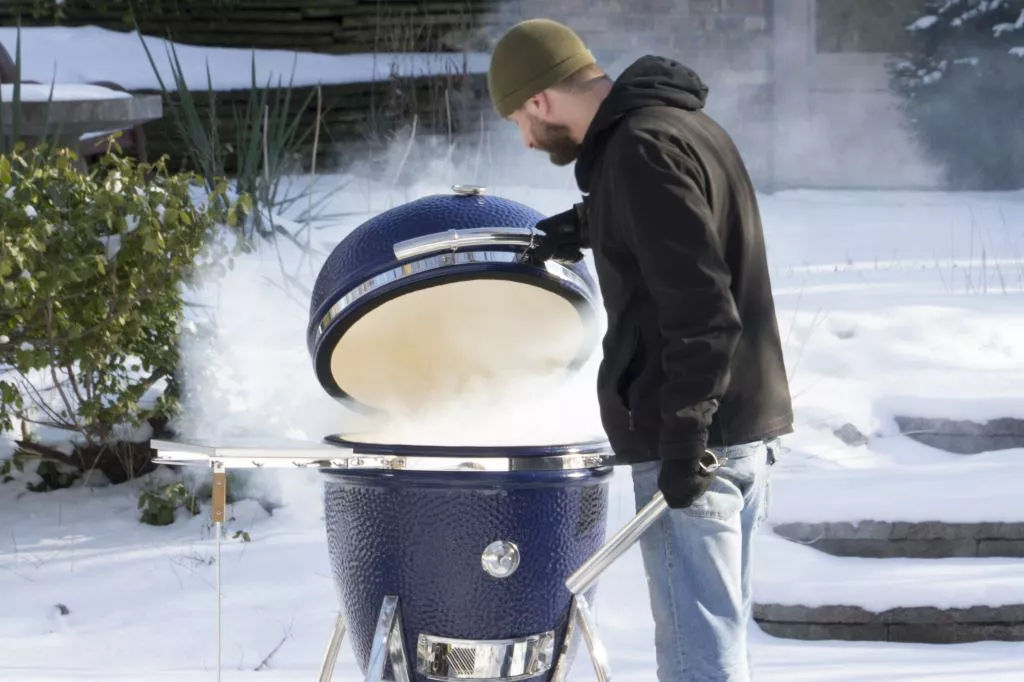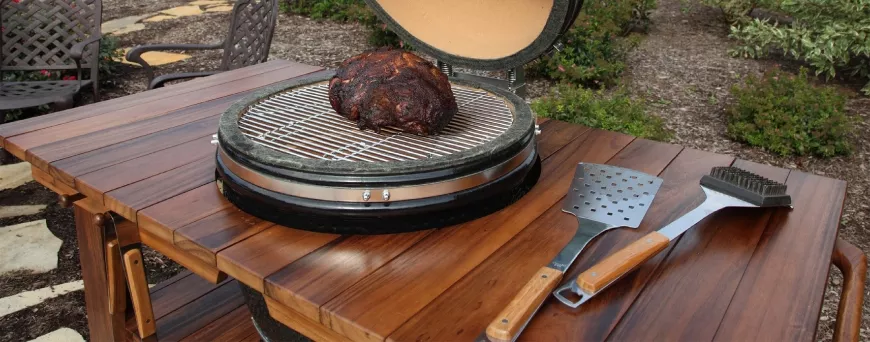304 Stainless Steel on a Kamado Grill
Why it Matters
304 stainless steel is:
- Beautiful
- Highly Rust Resistant
- Resistant to Peeling and Chiping
- Easy to Clean
- Food-Safe
- Strong
More generally, stainless steel keeps with the high-durability and beauty of the ceramic Saffire kamado design. Traditionally, the powder-coated hardware on a kamado is it’s greatest weak-point, and eventually becomes an eye-sore. Not so with 304 stainless steel!
Stainless Steel is Beautifully Elegant
Stainless steel has a beautiful shine due to the chromium component in the steel. The shiny steel makes a great accent to the elegant enameled ceramic grill body of a Saffire, whether that enamel is colored in Sapphire Blue or Onyx Black. In addition, it’s very easy to clean with water and dish detergent, so it stays looking bright, even after working hard in the grimiest conditions.
Highly Rust Resistant 304 Stainless Steel
Rust Kills! Grills, Anyway
Let’s face it, grills get rusty. We tend to keep them in moist areas throughout the year, and then we expose them to lots of grease and super hot temperatures when they are in use. We bring our grills out in the summer, and we don’t always remember to bring them back in or cover them up when they aren’t in use for a day or two. Yet even in the garage or tool shed moisture can eat away at your favorite outdoor grilling station. In the shed, water can leak in through cracks in the ceiling during a rain storm or move through the walls in the form of moisture afterward, and high heat in the Summer helps to turn a tool shed with moisture into a sauna. Cars track rain water and snowy, salty sludge from the road all year round into the garage. Your grill itself is subject to grease and moisture from the food you cook, which could get trapped underneath a grill cover, potentially leading to rust even when covered for protection. Is there any place that’s really safe for your grill?
304 Stainless Steel is Saffire's Answer
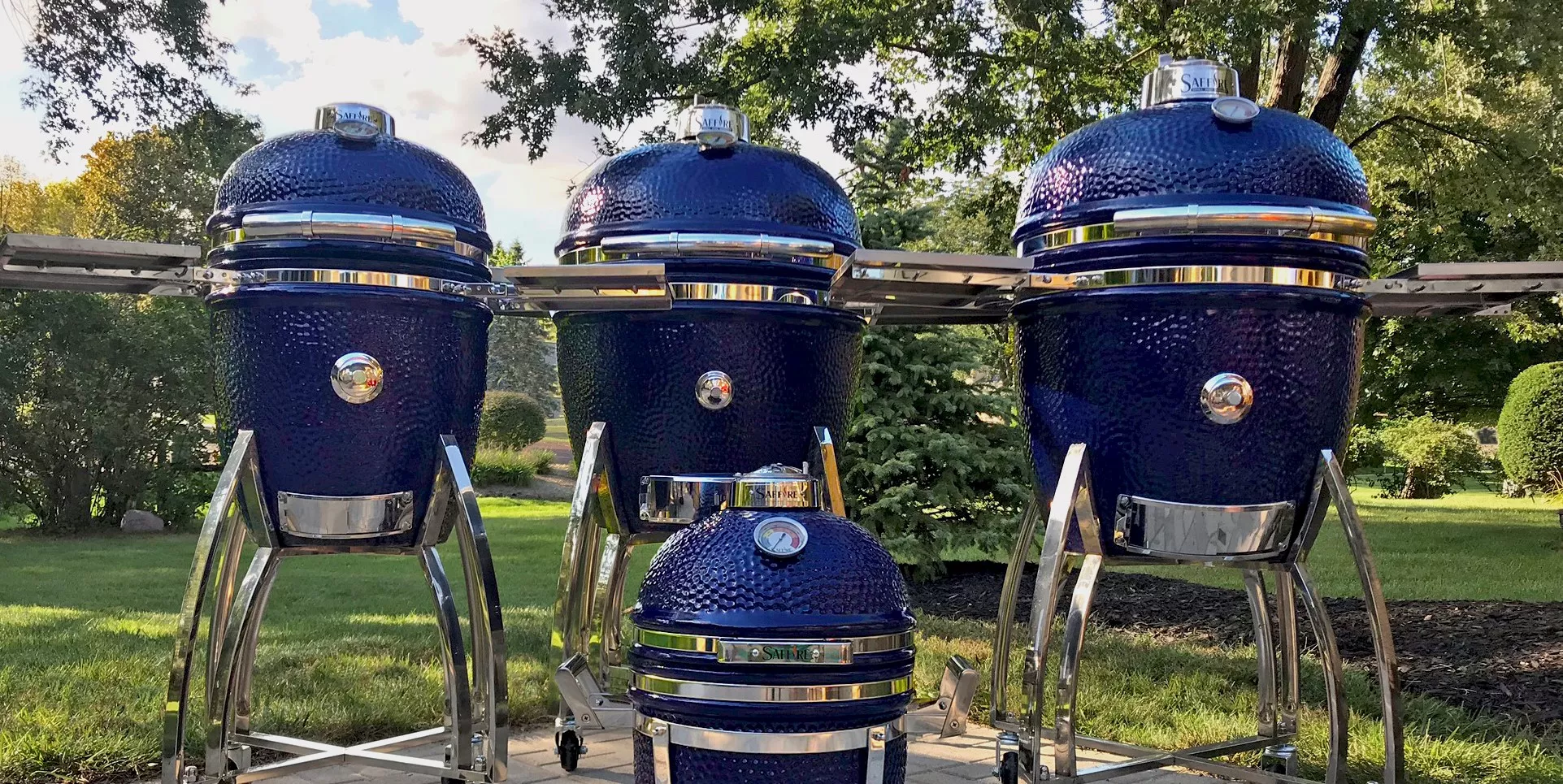
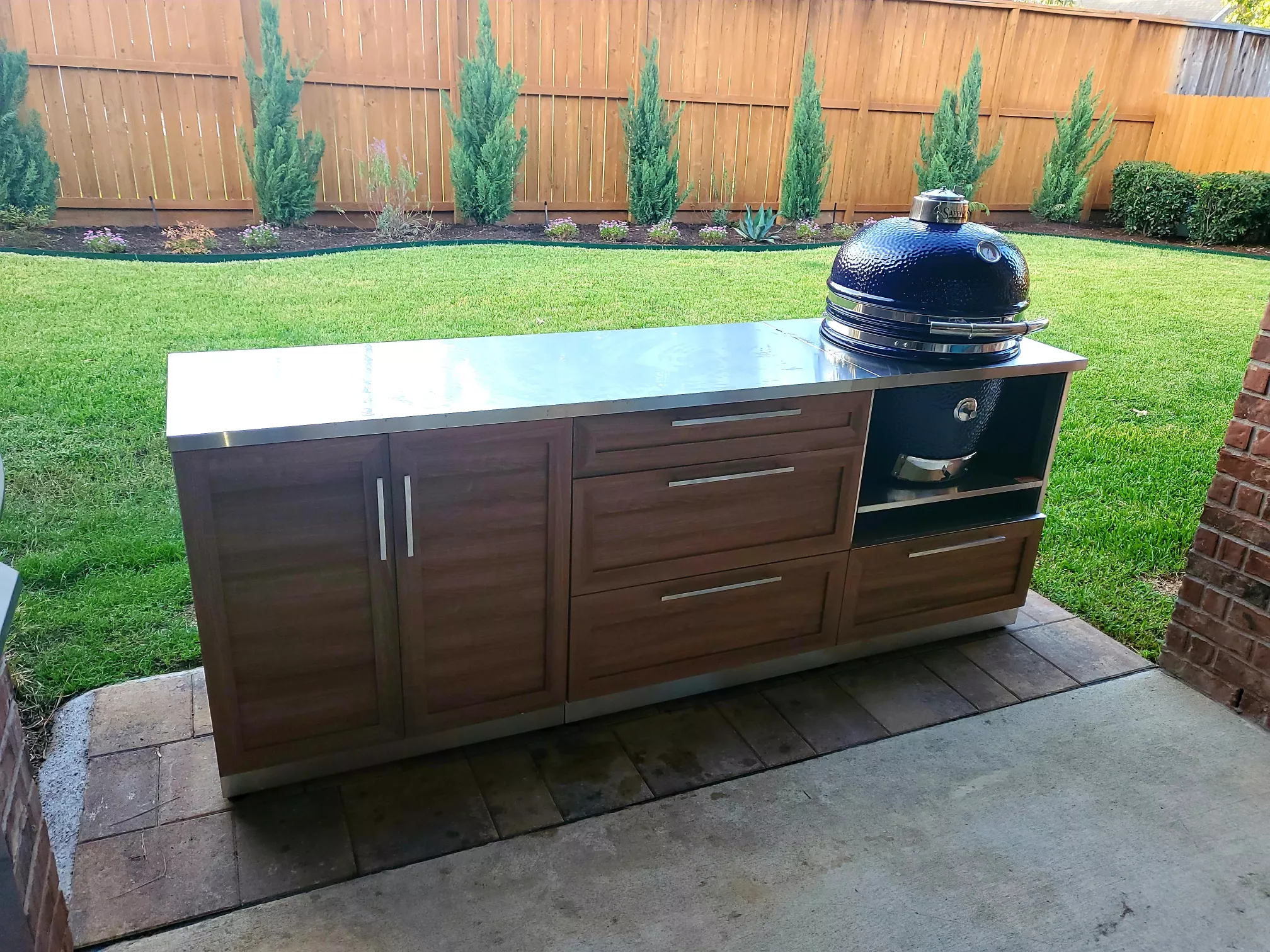
304 stainless steel is one of the more durable and rust-resistant metal alloys available for use with food. It’s very often used where food-grade metal is needed, as it’s safe, easy to clean, and not likely to introduce rust contaminants into the food. Saffire has specifically chosen 304 stainless steel to be our steel of choice for Saffire cooking grids and racks, and also for the chimney top, hinge, bands, and cart on our Platinum line of grills.
From the very beginning we intended our grills to optionally be used as build-in grills for outdoor kitchens and the like. Rust-resistance is a huge issue for all grills, but even more so when your grill is permanently built into a structure. Other kamados do not fair as well in the elements as a Saffire does, greatly lowering their lifespan when built into an immobile countertop. All high-quality built-in grills should be made from 202, 304, or 314 stainless steel, but not many kamados are. This innevitably leads to rusted bands and hinges. Even religiously covered built-in kamados will innevitably rust unless made of 202 or better stainless steel.
How to Maintain a Rust-Free Saffire Grill
- Clean Your Cooking Grates and Chimney Top — Grease build-up can look like rust on 304 stainless steel. Feel free to occasionally take your cooking grates and chimney top to the kitchen for a good, old-fashioned, soapy scrub-down in the sink.
- Avoid Really Hot Temperatures — Temperatures exceeding 725° F can damage the rust-resistant properties of stainless steel. We suggest not exceeding 700° F to best protect your cooking grid and cooking grid rack, as such high temperatures just aren’t necessary in normal use or cleaning.
- Cover Your Grill to Protect It from Ocean Spray, Road Salt, Chlorine, and Harsh Chemicals — 304 stainless steel does have a few weaknesses, and that is salt, chlorine, and harsh chemicals! Don’t allow salt, whether ocean salt or ice-melt salt, to stay on your grill! Cover your grill near the salty ocean, and spray it off with fresh water as soon as possible if you suspect any salt build-up has occurred. In addition, avoid putting your Saffire near any chlorine pool or hot tub. Especially do not place it by a hot tub, where chlorine fumes can damage and then rust the 304 stainless steel away! Finally, avoid using pesticides, herbicides, or other harsh or highly acidic chemicals around your grill.
Stainless Steel Won't Peel or Chip
One of the disadvantages of powder-coated hardware, which is the standard kamado hardware coating, is that it can chip. When powder-coated hardware chips, the metal underneath can begin to rust. Stainless steel is a forged steel alloy, so there is nothing to chip away or even peel. Saffire also offers the powder-coated hardware option in our less expensive Bronze lineup, but for the longest-lasting kamado experience, we do recommend the 304 stainless steel found in our Platinum lineup.
Easily Clean Your Kamado
Stainless steel isn’t difficult to keep clean. It doesn’t need harsh chemicals. In fact, for smaller, removable grill components like the cooking grid and chimney top, you can always take them off and give them a nice, hot, soapy bath in your kitchen sink. That’s good news, since the cooking grid and chimney top are two of the components that are going to see the most grease build-up on your grill!
For cleaning 304 stainless steel, we suggest avoiding strong acids like undiluted vinegar and chlorine-based bleaches. In most cases chlorine-free dish soap and water is the preferred cleaning methods. In some cases stainless steel cleaner can be used to get off deep-set stains. Distilled white vinegar, diluted to 5% or less acidity, can help to clean up smudges, but be sure to wipe the stainless steel clean of the vinegar after cleaning.
304 Stainless Steel is Food-Safe
Stainless steel is considered a food-grade material, meaning it can safely be used in industrial plants for storing, transporting, and processing food. Stainless steel is often found in the food industry, where sanitization and food safety are high priorities. Most professional kitchens utilize stainless steel for their pots, pans, and various utensils.
304 stainless steel is approximately composed of:
- 66-74% Iron
- 18-20% Chromium
- 8-11% Nickel
- 2% or Less of Manganese
- 1% or Less of Silicon
- Less Than 1% of Nitrogen, Carbon, Phospherus, Sulfur, and/or other elements
Nickel, when made into an alloy, is considered safe by the California OEHHA. In addition, stainless steel contains no measurable amounts of hexevalent chromium, which is known to the state of California to cause cancer and birth defects.
Another factor that makes stainless steel a food-grade material is how easy it is to disinfect. Electropolishing stainless steel, in particular, gives the steel a microscopically smooth finish, eliminating any surfaces on the steel where bacteria can build up without being cleaned.
In addition, unlike porcelain, stainless steel cooking grids won’t chip or crack. Porcelain chips can get into your food, making them undesirable on a cooking surface.
304 Stainless Steel is Both Strong and Durable
Stainless steel is stronger than iron, because chromium, nickel, and manganese (it’s chief components, besides iron) are stronger than iron. Stainless steel also is a work-hardened steel, meaning the hotter the steel gets, the harder it is to cut or puncture. In addition, the rust-resistant properties of 304 stainless steel make it super long-lasting under most normal conditions. It just makes sense to pair such a strong steel with a strong, mineral composite like ceramic.
Saffire’s cart legs use a tubular metal design, for the most rigidity. However, 304 stainless steel carts are even stronger than iron carts.
Other benefits of stainless steel include:

